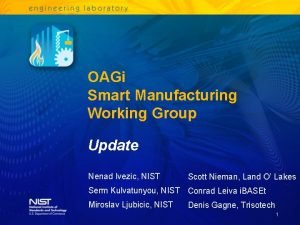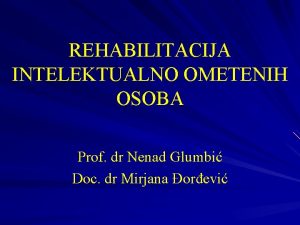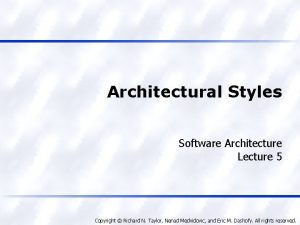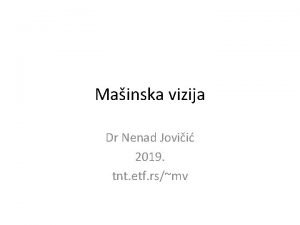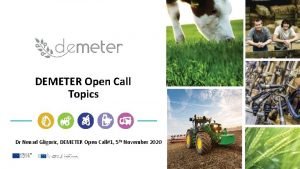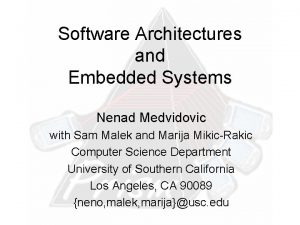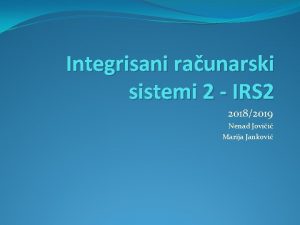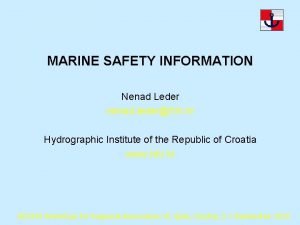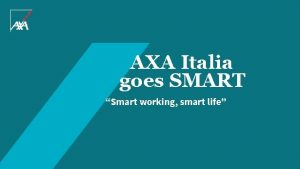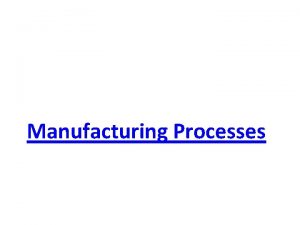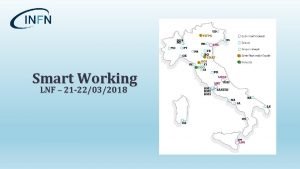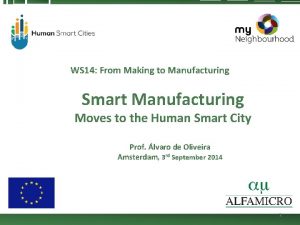OAGi Smart Manufacturing Working Group Update Nenad Ivezic






















- Slides: 22

OAGi Smart Manufacturing Working Group Update Nenad Ivezic, NIST Scott Nieman, Land O’ Lakes Serm Kulvatunyou, NIST Conrad Leiva i. BASEt Miroslav Ljubicic, NIST Denis Gagne, Trisotech 1

Agenda • 2016 NIST/OAGi Workshop: Drilling Down on Smart Manufacturing – Enabling Composable Apps • 2016 Model-based Messaging Standards Development Session • Business Process Cataloging and Classification/Contextualization System 2

NIST/OAGi 2016 Workshop: Overall Vision To Enable Agile, Cost Effective, Usage and Provision of Cloud-based Services to enable Smart Manufacturing Systems

A Manufacturer’s Strategic Vision: Cloud, Io. T @ Land O’ Lakes 4

A Vendor’s Vision: Cloud-Enabled Manufacturing Supply Chain 5

First Workshop • 2015 NIST/OAGi Open Cloud Architecture for Smart Manufacturing [Workshop Report NISTIR 8124]* • Identified critical issues Inadequate standards development processes Limited Difficult to use standards standard Overlapped and unclear standard capabilities adoptions New architecture needed Additional standards needed * http: //nvlpubs. nist. gov/nistpubs/ir/2016/NIST. IR. 8124. pdf 6

This Workshop • Model-based messaging standards development • Smart manufacturing marketplace • Smart manufacturing systems characterization • Crowdsourcing of manufacturing knowledge • Standards capability analysis 7

2016 Model-based Messaging Standards Development Session Motivation • Numerous legacy systems and processes • Large, complex, imprecise messaging specs • The lack of a common, syntax-independent integration specification • The lack of means for managing usage information of messaging specifications 8

Key Concept • Usage information of a messaging specification is a – customized messaging specification and – context for customized messaging specification, which is about: • integration goal, • business environment (industry sector, geolocation, etc. ), • means (use of standard codes, etc. ), • and other aspects essential for effective, repeatable, and traceable use of the specification 9

New Idea • Develop necessary measurement science, in the form of – reference models, – methods, – software tools, and – a knowledge base, • enabling life-cycle management of usage information of messaging specifications 10

Objectives • NIST and OAGi are engaged in enabling two new tools – Messaging Standard Semantic Refinement Tool (MSSRT) and – Business Process Cataloging and Classification/Contextualization System (BPCCS) 11

Messaging Standard Semantic Refinement Tool (MSSRT) • A web-based Saa. S application • Life-cycle management of customized messaging specifications • The POC software tool will validate – the multi-tenant methods and – meta-models for life-cycle management of customized messaging specifications • To be extended and commercialized by industry 12

Business Process Cataloging and Classification System (BPCCS) • A web-based Saa. S application • Life-cycle management of context for customized messaging specifications • The prototype software will validate – meta-model for life-cycle management of context for customized messaging specifications (that drive the evolution of the core messaging standard) • To be extended and commercialized by industry 13

Session Deliverable 1: Analysis of Messaging Standard (BOD) Subsetting Process Review Business Requirements Review Detailed Business Process(es) Determine if Canonical Pattern applies Determine if Noun is available Determine Verbs based on BPMN Activities Identify Application API options Data Mapping Canonical to/from API Create BOD Subset in GEFEG 14

Session Deliverable 2: Towards a Roadmap Barrier: Business process life-cycle management systems that meets: (1) Business-process-first as opposed to data-first integration method; (2) Top-down & bottom-up processes; (3) Component-level standard life-cycle management; (4) Context classification schemes ; (5) Business context management Approach: Business Process Cataloging and Classification/Contextualization System 1 -2 Years Roadmap Action Plan Milestones Target/Capabilities • Analyze candidate Smart Manufacturing use cases for BPCCS requirements • Analyze existing classification and contextualization schemes for SM business processes • Develop BPCCS meta-model and prototype BPCCS • SM Use Cases analysis • 3+ Mfg. use cases analyzed for requirements • Model SDO SM scenarios as BP models • Validate BPCCS in cooperation with SDO • Classification/Contextualizatio n Scheme Proposed • Catalog of SM Business Processes Prototyped • OAGIS Mfg. Scenarios standardized as Business Process Models • OAGIS-validated BPCCS • 80%+ priority requirements met • 80%+ OAGIS Mfg. Scenarios • Validated on the 3+ Mfg. use cases 3 -5 Years • Train an SDO membership for BPCSS use and adoption • Organize for BPCCS collaborative development • Re-design and prototype BPCCS as a cloud-enabled solution • Develop collaborative processes for top-down and bottom-up business process modeling • Catalog of SM Business Processes Populated • BPCCS adopted at SDO for collaborative development • 80% of OAGIS BP models populated in the BPCCS • At least 1 SM standard business process developed with SDO 5+ Years • Design and deploy BPCCS for use at SDO • BPCCS implementation deployed at SDO • 1+ SDO deployment 15

Session Deliverable 2: Road-mapping Basis Session Title SM Model-Based Standards Development and Implementation Vision Develop new methods and tools to make messaging standard development and usage more convenient, traceable, repeatable, consistent, and agile Business Problems • • Inconsistent integration methodologies Obtaining business buy-in to value proposition of standards-based integrations Difficulty changing culture (essential to standards-based integrations) Perceived long standards development cycle Large, cumbersome messaging standards Increased cost and reduced agility through duplication of effort (vs common services) Increased costs due to lack of understanding why traditional integrations break Vendor lock-in due to proprietary solutions (APIs, integration methods) Technical problem & Needed technical capabilities • • • Lack of a commonly accepted process to develop standard-based, service-oriented integrations Lack of tools to support collaborative, traceable standards development Implementation guidelines are rarely shared, poorly documented such that others can learn Lack of common tools and shared knowledge to support standards development lifecycle Inadequate meta-data repositories and supporting tools to enable standards and integration development and reuse Hard to educate technical resources about the value proposition of canonical pattern Software development tools cannot handle implementing the large standards Code-first APIs that are often too chatty Overly generic/vague APIs Managing semantics of standards New standards and technology needs (N) Barriers (B), and Approaches (SR, BPCCS) • A standardized process for developing and maintaining standard-based, service-oriented integrations (N) • [B] Assure business-process-first as opposed to data-first integration method (BPCCS) • [B] Enable middle-out, top-down & bottom-up processes (SR, BPCCS) • [B] Process that fits the small and large enterprise needs and constraints A collaborative tool to support collaborative and traceable standards development lifecycle (N) • [B] Accessible (e. g. , Saa. S-based) repository of messaging standards and implementation guides (SR) • [B] Component-level standards life-cycle management (SR, BPCCS) • [B]Consistent, and common integration requirements and feedbacks (? ) A collaborative tool to share, document, and discover standard usage experiences (N) • Cloud-based standards usage repository (SR) • Context classification schemes (SR, BPCCS) • Business context management (BPCCS) • • Priority Actions • • Formalize a process for better standard development and usage life-cycle management with and without (new) supporting tools. Capture tool requirements in support of the process Capture information from use cases for standard development and usage life cycle 16 Design the wizard-like tool

BPCCS – Enabling Model-Based Messaging Standards (BD) BPCCS Meta-Model Integrated Business Process (Use Case) Model-Based Development KB Model-Based Messaging Standards Development Activity Context for Customized Messaging Spec. To-Be BOD Deploy. Process + Tools 17

Example Input: A Business Process 18

Output: Context for Message Exchange in Support of BOD Subsetting

To-Be BOD Deployment Process + Tools

BPCCS Meta Model

Next Steps: Addressing Priority Items • Formalize a process for better standard development and usage life-cycle management with and without (new) supporting tools. • Capture tool requirements in support of the process • Capture information from use cases for standard development and usage life cycle • Design the wizard-like tool • Validate the proposed standards development lifecycle (SDLC) meta-model • Develop proof-of-concept that implements the metamodel 22
 Nenad ivezic
Nenad ivezic Working smart vs working hard
Working smart vs working hard Backup and recovery techniques
Backup and recovery techniques Manufacturing cost vs non manufacturing cost
Manufacturing cost vs non manufacturing cost Job costing vs process costing examples
Job costing vs process costing examples Cost concept and classification
Cost concept and classification Manufacturing cost vs non manufacturing cost
Manufacturing cost vs non manufacturing cost Additive manufacturing steps
Additive manufacturing steps Pastequick user ghost
Pastequick user ghost Glumbic fasper
Glumbic fasper Nenad glumbic fasper
Nenad glumbic fasper Nenad glumbic
Nenad glumbic Samim
Samim Nenad medvidovic
Nenad medvidovic Tnt etf
Tnt etf Demeter open call
Demeter open call Nenad medvidovic
Nenad medvidovic Nenad jovicic etf
Nenad jovicic etf Nenad mojsović
Nenad mojsović Nenad jovicic etf
Nenad jovicic etf Nenad roso
Nenad roso Nenad leder
Nenad leder Nenad mirkovich
Nenad mirkovich
